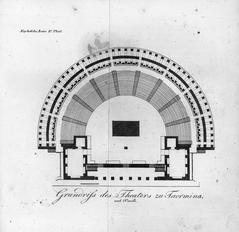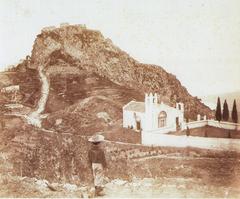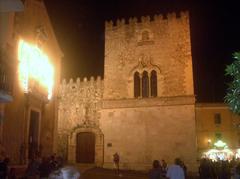Visiting Hours and Ticket Information for Duomo in Taormina, Italy
Date: 18/07/2024
Introduction
The Duomo of Taormina, also known as the Cathedral of San Nicola di Bari, is a captivating architectural and historical landmark located in the picturesque town of Taormina, Sicily. This medieval cathedral, with its roots tracing back to the 13th century, stands as a testament to the rich cultural heritage and diverse architectural influences that have shaped the region over the centuries. The Duomo’s unique blend of Romanesque, Gothic, Renaissance, and Baroque elements reflects the varied historical periods and cultural dynamics that have influenced its construction and evolution (Sicily Tourism) (Italy Magazine).
Located in the heart of Taormina, the Duomo serves not only as a place of worship but also as a central gathering spot for locals and tourists alike. Its strategic location in Piazza del Duomo makes it easily accessible and a focal point for cultural and social activities. The cathedral’s historical significance is further highlighted by its role as a refuge during medieval conflicts and as a gathering place during the Italian unification movement in the 19th century (Visit Sicily) (Sacred Destinations).
Visitors to the Duomo are often captivated by its fortress-like exterior, the intricate carvings of the main portal, and the serene ambiance of its Romanesque interior. The cathedral also houses several important works of art and religious artifacts, including a 15th-century wooden crucifix and a 17th-century silver reliquary of San Nicola di Bari, adding to its cultural and religious significance (Architectural Digest).
In this comprehensive guide, we will explore the Duomo’s fascinating history, architectural evolution, and cultural significance, while also providing practical information for visitors, including visiting hours, ticket prices, travel tips, and nearby attractions, ensuring an enriching and memorable experience for all who visit.
Table of Contents
Historical Background
Origins and Early History
The origins of the Duomo date back to the 13th century, around 1400 AD, when it was constructed on the ruins of a pre-existing church. This period was marked by the Norman influence in Sicily, which is evident in the architectural style of the Duomo. The Normans, who had conquered Sicily in the 11th century, left a significant imprint on the island’s architecture, blending Romanesque and Gothic elements.
Architectural Evolution
The Duomo’s architecture has undergone several transformations over the centuries. Initially built in a Romanesque style, the structure was later modified to incorporate Gothic elements. The façade, characterized by its crenellated walls, resembles a fortress, reflecting the turbulent times during which it was built. The main portal, adorned with intricate carvings, is a fine example of the Gothic influence. The interior of the Duomo retains a more austere Romanesque style, with a simple nave and two aisles separated by columns.
Renaissance and Baroque Influences
During the Renaissance period, the Duomo saw further modifications. The most notable addition from this era is the rose window on the façade, which adds a touch of elegance to the otherwise fortress-like exterior. The Baroque period brought about more significant changes, particularly in the interior decoration. The main altar, crafted in the 17th century, is a masterpiece of Baroque art, featuring intricate carvings and gilded details. The side chapels, added during this period, also showcase Baroque artistry, with elaborate altarpieces and frescoes.
The Bell Tower
The bell tower of the Duomo, which stands adjacent to the main structure, is another significant historical feature. Originally built in the 13th century, the tower has been rebuilt and modified several times. The current structure, which dates back to the 16th century, combines elements of Gothic and Renaissance architecture. The tower houses a set of bells, the oldest of which dates back to the 15th century, and continues to play a vital role in the religious and social life of Taormina.
Historical Events and Significance
The Duomo has been a witness to numerous historical events over the centuries. During the medieval period, it served as a refuge for the townspeople during times of conflict. The fortified structure of the Duomo provided a safe haven against invaders. In the 19th century, the Duomo played a central role in the Risorgimento, the movement for Italian unification. The church was a gathering place for local patriots who supported the cause of unification.
Preservation and Restoration
The Duomo has undergone several restoration projects to preserve its historical and architectural integrity. The most significant restoration took place in the early 20th century, when efforts were made to restore the original Romanesque and Gothic features that had been altered over the centuries. More recently, in the 21st century, the Duomo has been the focus of conservation efforts aimed at preserving its structural stability and artistic heritage. These efforts have been supported by both local authorities and international organizations dedicated to the preservation of cultural heritage.
Cultural and Religious Importance
The Duomo of Taormina is not only a historical monument but also a living center of religious and cultural life. It continues to serve as the main place of worship for the local Catholic community. The church hosts regular masses, religious festivals, and cultural events, making it an integral part of the community’s social fabric. The Feast of San Nicola di Bari, the patron saint of the Duomo, is one of the most important religious events in Taormina, attracting visitors from all over the region.
Art and Artifacts
The Duomo houses several important works of art and religious artifacts. Among the most notable are the 15th-century wooden crucifix, the 16th-century painting of the Madonna and Child, and the 17th-century silver reliquary of San Nicola di Bari. These artifacts not only hold religious significance but also provide insight into the artistic and cultural history of Taormina.
Visitor Information
Visiting Hours
The Duomo is open to visitors daily. Typical visiting hours are from 9:00 AM to 6:00 PM, but it’s advisable to check the official website of Taormina for any changes or special events that might affect these hours.
Ticket Prices
Entry to the Duomo is generally free, though donations are welcome to help with the maintenance and preservation of the church. For guided tours, there may be a small fee.
Travel Tips
- Best Time to Visit: Early mornings or late afternoons are ideal to avoid the crowds.
- Dress Code: Modest clothing is recommended as it is a place of worship.
- Photography: Allowed, but be respectful during religious services.
Nearby Attractions
- Ancient Theatre of Taormina: A short walk from the Duomo, this ancient Greek theatre offers stunning views of the Ionian Sea and Mount Etna.
- Corso Umberto: The main street of Taormina, lined with shops, cafes, and historical buildings.
- Villa Comunale: A beautiful public garden offering a tranquil escape with panoramic views.
Accessibility
The Duomo is accessible to visitors with mobility issues, with ramps and designated seating areas inside the church.
Modern-Day Relevance
Today, the Duomo of Taormina stands as a symbol of the town’s rich historical and cultural heritage. It attracts thousands of visitors each year, who come to admire its architectural beauty and historical significance. The Duomo is also a popular venue for weddings and other special events, adding to its modern-day relevance. The church’s role as a cultural and religious center continues to evolve, reflecting the dynamic history of Taormina.
Conclusion
The Duomo of Taormina is a must-visit for anyone interested in history, architecture, and culture. Its rich historical background, combined with its ongoing cultural and religious significance, makes it a unique destination.
FAQ Section
Q: What are the visiting hours for Duomo Taormina?
A: The Duomo is open daily from 9:00 AM to 6:00 PM. Check the official website for any changes.
Q: How much do tickets to Duomo Taormina cost?
A: Entry is generally free, but donations are welcome. Guided tours may have a small fee.
Q: What is the dress code for visiting the Duomo?
A: Modest clothing is recommended as it is a place of worship.
Q: Are photography and videography allowed inside the Duomo?
A: Yes, but be respectful during religious services.
References
- Discover the Duomo of Taormina - Visiting Hours, Tickets, and Historical Insights, 2024, Sicily Tourism
- Discover the Duomo of Taormina - Visiting Hours, Tickets, and Historical Insights, 2024, Italy Magazine
- Discover the Duomo of Taormina - Visiting Hours, Tickets, and Historical Insights, 2024, Visit Sicily
- Discover the Duomo of Taormina - Visiting Hours, Tickets, and Historical Insights, 2024, Sacred Destinations
- Discover the Duomo of Taormina - Visiting Hours, Tickets, and Historical Insights, 2024, Architectural Digest
- Visiting the Duomo of Taormina - History, Tickets, and Travel Tips, 2024, Social Spaces
- Visiting the Duomo of Taormina - History, Tickets, and Travel Tips, 2024, Economic Impact
- Visitor Tips for Duomo Taormina - Best Time to Visit, Admission, and Nearby Attractions, 2024, Educational Tours



